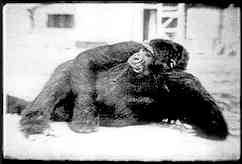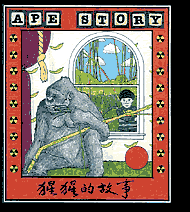Ape Story
is a composition for theater. The performance is two hours long, with five major scenes and three transitional technical DIS-PLAYS.

Ape Story
is set against a continuous two-hour, wide-screen, film projection. The sound accompaniment is diverse, with a series of compositions on the Chinese erh-hu weaving a musical theme. There are nineteen major performers and approximately 350 Chinese children in this highly choreographed work.

In the late 1920's, Franz Kafka wrote Report to an Academy, a short play about an ape addressing the scientific establishment with stories of life in captivity, trying to find freedom through communication.
In 1972 , I met Eugenie Chonnard, a then 84-year-old artist living in Santa Fe, New Mexico. In 1914 she was commissioned to live with and sculpt a bust of Dinah, the first captive gorilla in this country.
Throughout the 1970's, I video-documented and spent time with Koko, a young female gorilla initially raised at Stanford University, being studied and taught to communicate in American Sign Language.
For about 10 years, I would visit zoos and primate research facilities, when traveling. Once, at the Bronx Zoo, I met Carolyn, arthritic and nearly hairless, nearly 50, the oldest gorilla in captivity; and Huerfanita, who would sit and communicatively gesture to passer-bys.
Eventually, I composed a play about Dinah, an old gorilla able to talk with the aid of an implanted artificial larynx. She was entertaining, but after a while it was clear that she was also very confused.
The (1985) play, Ape Story, was to also feature an all-Chinese cast, Chinese translation and ehr-hu music, and a choreographed, ever-increasing gathering of Chinese children on stage, until no one could move.


